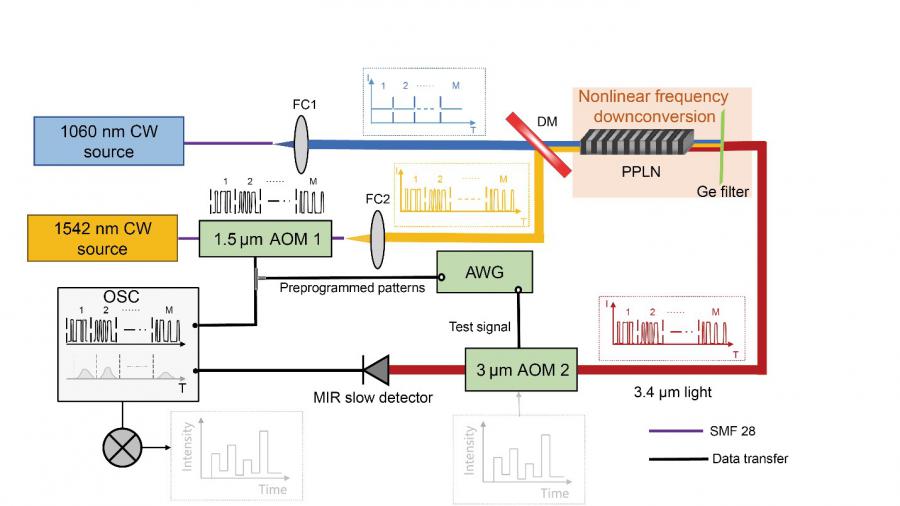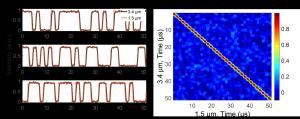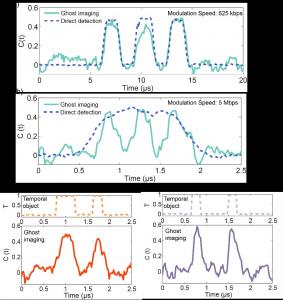
Proof-of-concept study demonstrates mid-infrared computational temporal ghost imaging
USA, August 31, 2024 /EINPresswire.com/ -- Mid-infrared (MIR) temporal ghost imaging allows for reconstructing fast temporal objects using a commercially available MIR slow photodetector. To toward this goal, Scientists in China conceived a frequency downconversion temporal ghost imaging scheme that enables us to realize computational temporal ghost imaging in the mid-infrared. The scheme is flexible and can be extended to other regimes, opening up new possibilities for scan-free pump-probe imaging and free-space communications in MIR regions.
Ghost imaging in the time domain allows for reconstructing fast temporal objects using a slow photodetector. The technique involves correlating random or pre-programmed probing temporal intensity patterns with the integrated signal measured after modulation by the temporal object. However, the implementation of temporal ghost imaging necessitates ultrafast detectors or modulators for measuring or pre-programming the probing intensity patterns, which are not available in all spectral regions especially in the mid-infrared region.
In a new paper (doi: https://doi.org/10.1038/s41377-024-01426-0) published in Light Science & Applications, a team of scientists, led by Prof. Houkun Liang from Sichuan University, China and Prof. Goëry Genty from Tampere University, Finland, and co-workers have developed a frequency downconversion temporal ghost imaging (TGI) scheme that enables to extend the operation regime to arbitrary wavelengths regions where fast modulators and detectors are not available. The approach modulates a signal with temporal intensity patterns in the near-infrared and transfers the patterns to an idler via difference-frequency generation in a nonlinear crystal at a wavelength where the temporal object can be retrieved.
As a proof-of-concept, scientists demonstrated a computational temporal ghost imaging in the mid-infrared with operating wavelength that can be tuned from 3.2 to 4.3 μm. The scheme is flexible and can be extended to other regimes. The results introduce new possibilities for scan-free pump-probe imaging and the study of ultrafast dynamics in spectral regions where ultrafast modulation or detection is challenging such as the mid-infrared and THz regions. These scientists summarize the operational principle of mid-infrared temporal ghost imaging:
“The absence of suitable instrumentation, such as ultrafast mid-infrared electro-optic modulators for pre-programming temporal patterns at mid-infrared light sources, has been a bottleneck in the direct implementation of computational TGI in the mid-infrared. In the proposed new scheme, instead of directly pre-programming temporal patterns at mid-infrared wavelengths, we modulate pre-programmed temporal patterns at near-infrared wavelengths using a conventional telecom modulator and, subsequently, these modulated patterns are transferred to a mid-infrared idler via difference-frequency generation using a temporally stable continuous-wave near-infrared pump light source.”
“The wide availability of tunable lasers in the near-infrared allows for flexible and versatile operation of the downconversion TGI scheme, enabling to extend TGI to wavelength regimes where there is a lack of fast detectors and modulators. Using this approach, we have experimentally demonstrated computational TGI in the wavelength range from 3.2 to 4.3 μm. Besides, orthogonal temporal patterns can be used in computational downconversion TGI to reduce the number of distinct probing measurements.” they added.
“The presented technique can provide new possibilities for the study of ultrafast dynamics in the mid-infrared spectral region and high-speed free-space optical communications in atmospheric transmission windows even in the presence of atmospheric turbulence. We emphasize that the concept of frequency downconversion ghost imaging is generic, and it can also be applied in the spatial and spectral domains, which could open a new venue for single-pixel imaging and spectroscopy in the mid-infrared and THz regions” the scientists forecast.
DOI
10.1038/s41377-024-01426-0
Original Source URL
https://doi.org/10.1038/s41377-024-01426-0
Funding information
This work was supported by National Natural Science Foundation of China (62375189, 62311530045, 62005186, 62075144), Sichuan Outstanding Youth Science and Technology Talents (2022JDJQ0031), Engineering Featured Team Fund of Sichuan University (2020SCUNG105) and the Research Council of Finland (320165, 356243 and 333949).
Lucy Wang
BioDesign Research
email us here
Distribution channels: Science, Technology
Legal Disclaimer:
EIN Presswire provides this news content "as is" without warranty of any kind. We do not accept any responsibility or liability for the accuracy, content, images, videos, licenses, completeness, legality, or reliability of the information contained in this article. If you have any complaints or copyright issues related to this article, kindly contact the author above.
Submit your press release


